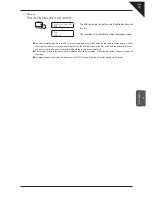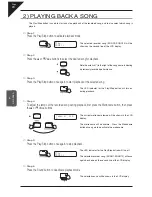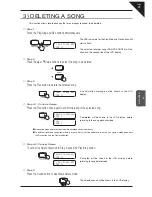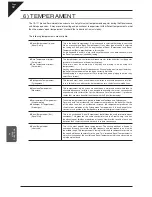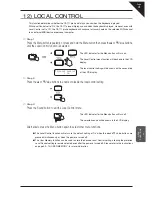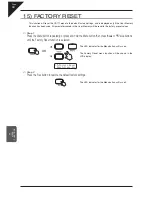
Page
33
7
MENU
FUNCTIONS
Step 1
Press the Menu button repeatedly, or press and hold the Menu button then press the
S
or
T
Value buttons,
until the Temperament function is selected.
The LED indicator for the Menu button will turn on.
The Temperament menu function will be shown in the
LCD display.
The temperament type will be shown on the second line
of the LCD display.
Step 2
Press the
S
or
T
Value buttons to select the desired temperament type.
After selecting the desired temperament type, please refer to the instructions on page 34 - 7) KEY OF TEMPERAMENT
- for information regarding the key signature of the selected temperament.
Step 3
Play the piano.
The temperament selected in Step 2 will be utilised for
the sound.
Step 4
Press the Sound button to exit the Temperament menu.
The LED indicator for the Menu button will turn off.
The selected sound will be shown in the LCD display.
Alternatively, press the Menu button again to select other menu functions.
The Temperament function will return to the default setting of ‘Equal Temperament (piano)’ when the
S
and
T
Value
buttons are pressed simultaneously, or when the power is turned off.
The User Memory function can be used to store the desired Temperament setting, allowing the preferred Temperament
setting to remain selected even after the power is turned off. Please refer to the instructions on page 43 - 14) USER
MEMORY - for more information.
Equal Temperament (piano)
ÇÈ
Pure Temperament (major)
Pure Temperament (minor)
Pythagorean Temperament
Meantone Temperament
Æ
Å
Equal Temperament (stretched)
Equal Temperament (fl at)
Kirnberger III Temperament
Werckmeister III Temperament
ÇÈ
S
T
Value button
6.Temperament
=
Equal(P.only)
6.Temperament
=
Pure(minor)
6.Temperament
=
Pythagorean
6.Temperament
=
Meantone
6.Temperament
=
Equal
6.Temperament
=
Equal(f at)
6.Temperament
=
Kirnberger
6.Temperament
=
Werkmeister
6.Temperament
=
Pure(major)
Æ
Å
Æ
Å
Æ
Å
Æ
Å
Æ
Å
OR
6.Temperament
=
Equal(P.only)
CA111̲EN.indd 33
2008/04/12 0:58:55

